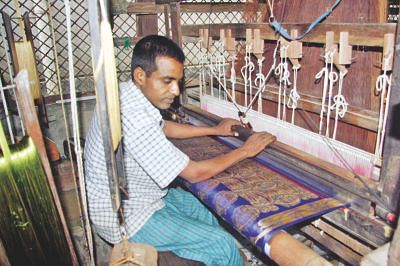Protecting Jamdani with Geographical Indications
Protecting Jamdani with Geographical Indications

THE Agreement on Trade Related Aspects of Intellectual Property (TRIPS) defines geographical indications (GI) as “indications which identify a good as originating in the territory of a Member, or a region or locality in that territory, where a given quality, reputation or other characteristic of the good is essentially attributable to its geographical origin.” The raison d'être of extending intellectual property rights protection to geographical indicative marks of a product is to protect such product against “misleading use,” and “unfair competition.”
In Bangladesh, there are region-specific handicrafts, sweets, fruits, tea and other household products for which GI can be made relevant to guard against misleading use or unfair competition. However, there is a wider public campaign for the GI protection of Jamdani sari, the quintessence of indigenous craftsmanship in traditional Bangladeshi weaving. The different varieties of Jamdani, including the flowery Muslin sari, have been glorified as the token of Bangladeshi handloom industry for centuries. This finery is a favourite attire for sari wearing communities at home and abroad. Given this, people have many reasons to seek GI protection for Jamdani: the probable financial gain from the GI-protected Jamdani is one, the national pride and identity is certainly another.
The enactment of the Geographical Indications of Goods (Registration and Protection) Act in 2013 gives new impetus to the policy advocacy to protect Jamdani as GI for its market value and to preserve it as a national heritage. This Act provides legislative protection to geographical indications as required under Article 62.1 of the TRIPS. However, mere passing of the Act in the Parliament is not sufficient to register GI of Jamdani because the bureaucratic details -- such as prescribed forms, procedure, fees etc. -- are yet to be formulated in rules. The government is yet to frame necessary rules for the Act, and as a consequence, the GI of Jamdani still remains unregistered in Bangladesh.
It is pertinent to mention here that instead of waiting for a new GI Act, we could have given protection to Jamdani or any other GI product by incorporating provisions needed for that purpose in our Trademarks Act. The United States protects GIs as trademarks, collective marks, or certification marks by employing the existing trademark regime under the Lanham (Trademark) Act 1946. However, we failed to take a prudent decision because of our parochial outlook.
Meanwhile, Uppada Jamdani sari has been registered as GI of the tiny fishery village Uppada in Andhra Pradesh. This registration underscores that protecting Jamdani from losing its GI recognition requires the same delicate approach as that of the artisans who make this expensive finery. Against the backdrop of the Indian registration of Uppada Jamdani, this article outlines the future legal process to protect our Jamdani as GI in Bangladesh and overseas.
Due to the territorial nature of protection for an “industrial property,” GI along with trademark and others belonging to this category, does not get any “automatic protection.” This means protection of GI in any particular country requires fulfillment of legal formalities of that country. The traditional process is that any product that falls under the definition of GI in the country of origin must be registered as GI in that country. This registration in the home country gives the product formal recognition and makes it eligible to get protection in other countries. Further, Members of the TRIPS must give “legal means” to interested parties to protect and defend the GI of their products against any misleading use and unfair competition. Members are also required, either ex officio or at the request of interested parties, to refuse or cancel trademark registration containing GI if the imputed registration or application for registration gives false origin or attribution. Given the fact that Upadda Jamdani has been registered in India as a GI product, the Jamdani weavers of Bangladesh, after getting its GI registration at home, have to make an application under Section 27 of Indian Geographical Indications of Goods (Registration and Protection) Act 1999 for the cancellation of Uppada Jamdani from the official register in India.
The decision of the Registrar of Geographical Indications of India will determine further administrative and legal battle to delist Uppada Jamdani from the official register. If either of the parties chooses to appeal against the decision of the Registrar then, according to Section 31, the appeal shall go to the Appellate Board constituted under the Act. The Appellate Board is the highest forum for this matter, unlike Bangladesh there is no option to go to the Indian Supreme Court for appeal. In a comparable situation, India successfully resisted the turmeric related patent in the United States.
Since the remedies are exhausted in India after its Appellate Board's decision, if the Uppada Jamdani still remains registered as GI, Bangladeshi stakeholders can resort to the WTO's dispute settlement system. However, interest holders who are mainly private parties have no standing in the WTO procedures; for this matter they “must rely on their government to bring or defend an action, or to intervene as a so-called third party.” A 'third party' is a Member of the WTO who is not a party to the dispute but “has a substantial trade interest in the matter at dispute.”
Therefore, Bangladesh as a Member should get involved at this stage since trade interest of the state is increasing in Jamdani. The dispute settlement process has three phases. In the first phase Members must enter into a mandatory consultation which lasts at least sixty days. If it fails, in the second stage the complaining Member may request the Dispute Settlement Body (DSB) to establish a 'Panel,' which is conventionally comprised of three members who are not citizens of the contending parties. A party to the dispute may appeal to Appellate Body, if it is unhappy with Panel's decision. Third phase is implementation of the Panel or Appellate Body's decision by the DSB.
The writer is Associate Professor, Department of law, Dhaka University.